Here’s the World-Changing Historical Figure with Your Myers-Briggs® Personality Type
Curious which historical figure has your Myers-Briggs® personality type? Want to be inspired by someone in history who literally changed the world? You’re in the right place!
Many of us are living life like we’re desperately trying to beat level 1476 in Candy Crush. We’re doing just enough to get by, scraping through levels of work, relationships, and personal growth with a lack of enthusiasm and sometimes a lack of vision. We’re like the human equivalent of that guy who brings store-bought cookies to the potluck—technically contributing, but we all know you could do better, Kevin.

And that’s where this article comes in. This isn’t just a gentle nudge in the right direction, this is a full-on Spartan kick into the pit of potential. We’re going to delve into the lives of some of history’s most influential figures—some of them saints, others, well, let’s just call them ‘colorful characters’. Each of these people reached the peak of their potential, harnessing all the strengths of their personality types and using other talents as well. So, with that in mind, let’s ditch the Candy Crush life and start living like we mean it.
Not sure what your personality type is? Take our in-depth, visual personality questionnaire here. Or you can take the official MBTI® here.
The World-Changing Historical Figure with Your Myers-Briggs® Personality Type
Table of contents
- The World-Changing Historical Figure with Your Myers-Briggs® Personality Type
- ENTP – Leonardo da Vinci
- ENFP – Walt Disney
- INTP – Charles Darwin
- INFP – William Shakespeare
- ESTP – John F. Kennedy
- ESFP – Julius Caesar
- ISTP – Miyamoto Musashi
- ISFP – Thich Nhat Hanh
- ENTJ – Napoleon Bonaparte
- ENFJ – Martin Luther King Jr.
- INTJ – Nikola Tesla
- INFJ – Mary Wollstonecraft
- ESTJ – Henry Ford
- ESFJ – General Colin L. Powell
- ISTJ – George Washington
- ISTJ – George Washington
- ISFJ – Mother Teresa
- What Are Your Thoughts?
ENTP – Leonardo da Vinci

Ah, Leonardo da Vinci, the ultimate Renaissance man and poster child for ENTP personalities. This guy was never satisfied with mastering just one field. Oh, you’re a painter, Leo? That’s nice, but what about being a sculptor, architect, musician, mathematician, engineer, inventor, anatomist, geologist, cartographer, botanist, and writer? That’s right, Leonardo was the human embodiment of the Ne compulsion to explore many possibilities and angles.
Da Vinci’s notebooks, packed with sketches, inventions, and theories, are a testament to his ExxP exploratory, freedom-loving nature. Filled with ideas ranging from flying machines to studies on the human body, these notebooks show a mind that was constantly buzzing with ideas and a thirst for knowledge that couldn’t be quenched.
And let’s not forget his TP desire to dive deep into analysis. He didn’t just paint the “Mona Lisa” with that enigmatic smile; he probably spent hours contemplating the balance of her facial muscles and how they contribute to that smirk. And don’t even get me started on his “The Last Supper” and its use of vanishing point perspective. Talk about a Ti perfectionist.
So yes, Leonardo da Vinci, the stereotype of an ENTP – a mind never at rest, always moving from one project to another. If he were here today, he’d probably be trying to figure out how to turn his helicopter design into the next big thing on Kickstarter.
You might also like: 10 Must-Read Books for ENTPs
ENFP – Walt Disney
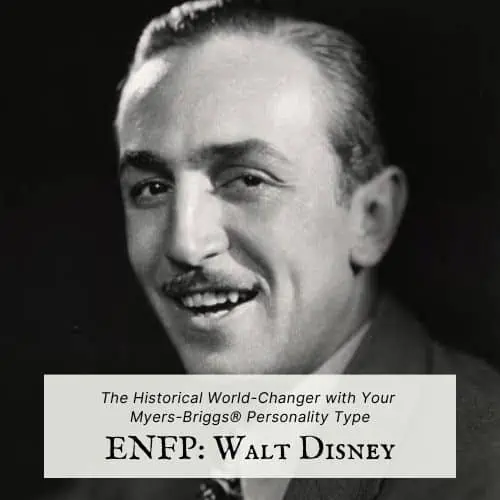
Now let’s talk about our ENFP world-changer, Walt Disney. This guy was the Picasso of daydreaming and a trailblazer in the world of imagination. Walt Disney, the epitome of an ENFP, was all about pushing the boundaries of the possible and the probable into the realm of the “Oh my, did he really just do that?”
An ExxP at heart, Disney was never content with just coming up with new ideas; he wanted to bring them alive, put them on the big screen and let them loose in the theme parks. He wasn’t just about the dreaming; he was about the doing. He wasn’t afraid of risks; in fact, he probably had a hotline to Risk Central, ordering a dozen risks for breakfast with his morning coffee.
There was the time when he bet the farm on a mouse with red shorts and large ears – you might know him, his name’s Mickey. Then, in the middle of the Great Depression, a time when people were selling apples on street corners, Disney was creating a full-length animated movie. Many naysayed it as “Disney’s Folly”, but “Snow White and the Seven Dwarfs” turned out to be a stupendous success! And let’s not forget Disneyland. Despite being over-budget and behind schedule, with many predicting its doom, Disney’s dream ‘land’ turned out to be anything but a ‘dismal land’.
But let’s not forget that Disney was also an Fi (Introverted Feeling) superhero. His unwavering conviction in following his dreams, combined with his heartfelt, charitable endeavors, showed the world the power of true belief and philanthropy. He didn’t just create Disneyland – he founded the California Institute for the Arts, ensuring that future generations would have a place to nurture their own creative visions.
I think Walt Disney is a perfect example of an ENFP at their best. If he were around today, he would likely be pondering the next frontier of animation, while simultaneously setting up a free art class for underprivileged kids. And he would do it all with that signature Disney twinkle in his eyes.
Find out more about ENFPs: A Look at the ENFP Leader
INTP – Charles Darwin
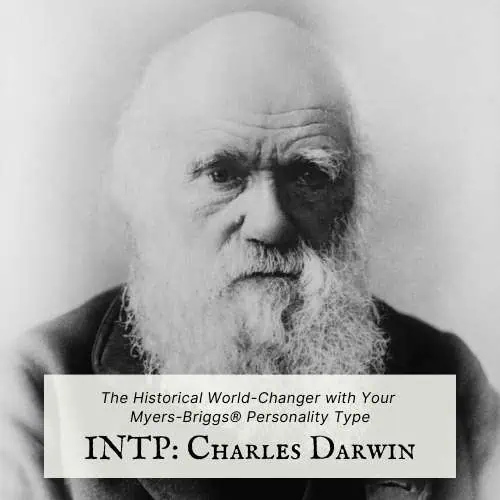
If you’ve ever wondered what an INTP looks like when they’re out in the wild – or more accurately, studying the wild, Darwin’s your man. This guy was the master of the long game, spending twenty years perfecting his theory of evolution before publishing “On the Origin of Species”.
As an INTP, Darwin loved his alone time. He spent years on the HMS Beagle, voyaging around the world, observing and collecting specimens. Now, that’s dedication – or the ultimate excuse to avoid small talk, take your pick.
Darwin had an insatiable thirst for knowledge. He didn’t just accept the status quo, he questioned it, analyzed it, and then upended it with his groundbreaking theories. That’s the Ti (Introverted Thinking) at work. Always analyzing, always questioning. And his Ne (Extraverted Intuition)? That kicked in as he connected the dots between different species and came up with the idea of natural selection.
And let’s not overlook his “I couldn’t care less about your social norms” attitude. Darwin essentially flipped the bird at the prevailing belief in Creationism and presented a theory that challenged the very tenets of the scientific and religious communities of his time. Talk about an INTP move!
Want to know more about INTPs? A Look at the INTP Leader
INFP – William Shakespeare

Let’s tiptoe into the mind of another master of words, the Bard himself – the quintessential INFP, William Shakespeare. Passionate and creative, Shakespeare could juggle words like circus performers juggle flaming torches – with flair, finesse, and of course, a little danger.
Ever wondered why we still study Shakespeare’s works in schools, centuries after he wrote them? It’s because he had the uncanny ability to dive into the human soul, explore its deepest recesses, and emerge with universal truths that resonate with us even today. This is the INFP drive: to expertly plumb the depths of human emotion and experience.
Shakespeare’s world was one of iambic pentameter, star-crossed lovers, vengeful ghosts, and power-hungry kings – all products of his rich, vivid imagination. This was a man who created entire universes within the confines of a theatre.
His Fi (Introverted Feeling) function is evident in his empathetic, complex characters that ranged from the tragically flawed Macbeth to the endlessly optimistic Portia. This man could empathize with kings and paupers alike, and he had a knack for putting these complex emotions into words that still tug at our heartstrings.
And let’s not forget about his Ne (Extraverted Intuition) function. He didn’t just write plays; he rewrote the rules of drama, creating new genres and pushing the boundaries of what was considered ‘acceptable’ in his time.
If Shakespeare were around today, he’d probably be pushing the boundaries of virtual reality, creating immersive plays where the audience could literally walk in the shoes of his characters. Or perhaps he’d be pushing back against our increasingly tech-driven world, reminding us of the power and beauty of human connection.
Discover more about INFPs: 3 Weird and Wonderful Secrets of the INFP Personality Type
ESTP – John F. Kennedy
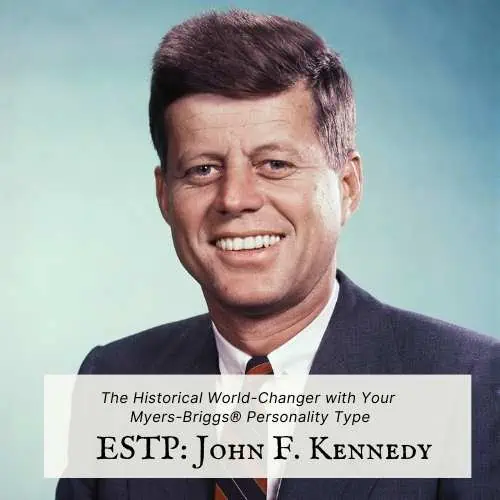
Let me introduce you to John F. Kennedy—charismatic, pragmatic, and adventure-loving. This guy was the poster boy for ESTPs. He loved the freedom of being at the helm, steering the ship of state with the wind in his hair, literally and metaphorically. And let’s not forget his ability to take on risks with a calm, competent face. Whether it was challenging the nation to land on the moon or tackling the Cuban Missile Crisis, Kennedy was never one to back down from a daring endeavor.
But beneath that cool, charismatic exterior was a Ti (Introverted Thinking) ninja. Kennedy was known for his logical, analytical mind. He didn’t just act on a whim; he dove deep into the issues. He understood the importance of precise, accurate information, which he used to make sound decisions. This was the guy who, during the Cuban Missile Crisis, analyzed every possible scenario, understood the potential consequences, and then, with the precision of a chess master, made the moves that prevented nuclear war.
If Kennedy were alive today, he’d probably be out there, whipping up public enthusiasm for some new, audacious goal—like colonizing Mars, perhaps. He’d be analyzing the situation, understanding the risks and the rewards, and then, with that trademark Kennedy charm, urging us to go forth and conquer. Because, you know, why not? For Kennedy, life was all about taking on challenges, understanding them, and then beating them into submission with sheer determination and a healthy dose of charisma.
Find out more about ESTPs: Understanding ESTP Sensing
ESFP – Julius Caesar
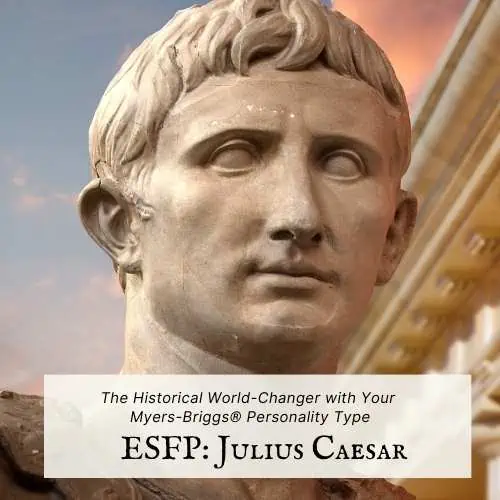
Allow me to introduce you to the legendary Roman General and statesman, the one and only, Julius Caesar. This man had people skills that could make even the grumpiest of senators crack a smile. A real man of the people, he’d fight alongside his soldiers, and not from some plush, feather-stuffed tent a safe distance away. Nope, he was right there in the muck and the mire, battling it out shield-to-shield, sword-to-sword. In fact, legend has it he knew every one of his soldiers by name. He was not just a talker, he was a doer—a characteristic that lies at the heart of the ESFP personality type.
Designing Rome? Oh, he had a hand in that too, shaping the city with grandeur and spectacle that remain unrivaled even today. From the Julian calendar to public works, Caesar wasn’t just about conquering territories, he was a visionary who reshaped the very fabric of the Roman Empire.
But let’s not romanticize him too much. After all, controversy and Julius Caesar were as inseparable as two sides of a denarius. He sparked a civil war, declared himself ‘dictator in perpetuity’, and his rumored affairs would give any tabloid a field day.
Trying to pin down the real Caesar is like trying to catch a slippery eel – just when you think you’ve got a hold, you realize you’re grasping at shadows. The man was a riddle, wrapped in a mystery, inside an enigma, wearing a toga. However, his magnetic personality, his flair for the dramatic, and his ability to read people, and play to the crowd, all point towards an ESFP personality.
In the end, Caesar was a man who both reveled in and understood the importance of spectacle – a trait that is quintessentially ESFP. He was a man who lived by his Sensing and Feeling functions – always in the moment, always in tune with the people around him. And just like a true ESFP, he had the ability to turn every situation – no matter how dire – into an opportunity to shine. If that’s not the ultimate ESFP move, I don’t know what is!
Discover more about ESFPs: 7 Ways That ESFPs Make an Impact
ISTP – Miyamoto Musashi
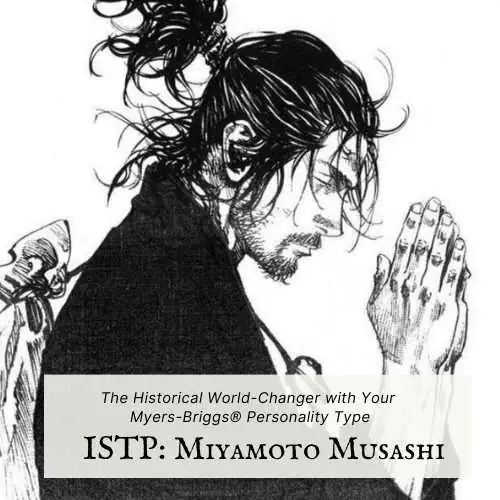
Alright, now let’s venture into the world of the samurai, where we encounter a legendary figure who perfectly embodies the spirit of the ISTP: Miyamoto Musashi. This man was no ordinary warrior—he was Japan’s most revered swordsman and still remains a symbol of stoicism and discipline.
Musashi was a man of action. He didn’t sit around, twiddling his thumbs or philosophizing about the nature of the universe. No, he was out there, practicing his swordsmanship, honing his skills, and developing a unique, two-sword fighting style (Niten Ichi-ryu) that would become his legacy. Very much like an ISTP, Musashi was practical, hands-on, and focused on the here-and-now.
His Ti (Introverted Thinking) function is reflected in his precise approach to combat, which involved understanding his opponent’s tactics, identifying their weak points, and then exploiting those weaknesses. This wasn’t a man who relied on brute strength; he was a tactician, a strategist, a man who viewed battle as a mental challenge.
Now what about his Se (Extraverted Sensing)? Look no further than his keen observational skills, his ability to read his opponents, and his heightened awareness of his environment. Musashi was said to have an uncanny ability to perceive even the slightest movements in his opponents, allowing him to anticipate their actions and respond accordingly.
If Musashi were alive today, he’d probably be a top-tier chess player, a military strategist, or even a groundbreaking scientist, constantly exploring, experimenting, and pushing the boundaries of what’s possible. Because that’s what an ISTP does—they engage with the world, consume knowledge, and then use that knowledge in practical, innovative ways. And they do it all with a sense of spontaneity and independence that’s as refreshing as a swift samurai sword strike.
Find out more about ISTPs: 10 Things You Should Never Say to an ISTP
ISFP – Thich Nhat Hanh
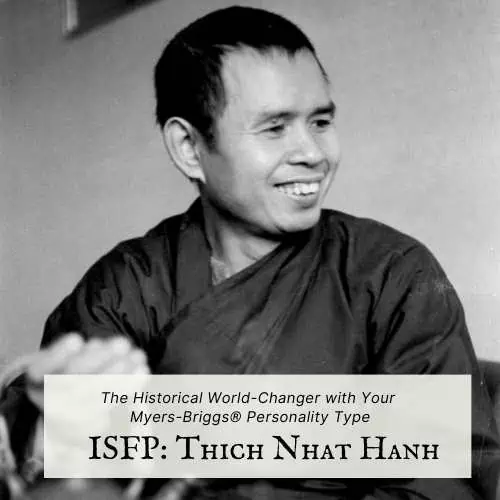
Now let’s embark on a spiritual journey with an individual who embodies the peace, creativity, and sensitivity of an ISFP – the Zen master, poet, and peace activist, Thich Nhat Hanh. This man is like a walking, talking meditation. Living proof that you can change the world while remaining calm and centered.
Think about an ISFP – they’re quiet, observant, and with an inner world that’s as rich and diverse as a Jackson Pollock painting. That’s Thich Nhat Hanh, a man devoted to ‘mindfulness’, a word he practically made mainstream. His teachings about compassion, interbeing, and mindfulness have transformed lives around the world. You know you’re dealing with a powerhouse of inspiration when Oprah Winfrey and Martin Luther King Jr. are among your fans.
His Fi (Introverted Feeling) function is apparent in his compassionate teachings, his deep understanding of human emotions, and his lifelong dedication to peace activism. Hanh’s work is driven by his profound empathy for all sentient beings and his desire to relieve suffering in the world. You see that passion, that conviction? That’s the Fi function in full throttle.
Then, let’s talk about his Se (Extraverted Sensing) function. This comes across in his teachings on mindfulness – living in the present moment, and fully experiencing life through our five senses. This is a man who can find joy in a leaf, beauty in a pebble, and wisdom in a daisy.
Hanh is still alive today, and he’s still inspiring people to lead more mindful and compassionate lives. And that’s the thing about ISFPs – they may be quiet, but their impact is anything but silent. They touch hearts, challenge minds, and inspire change through their gentle yet powerful presence.
Learn more about ISFPs: Are ISFPs Rare? Unleashing the Mystery
ENTJ – Napoleon Bonaparte
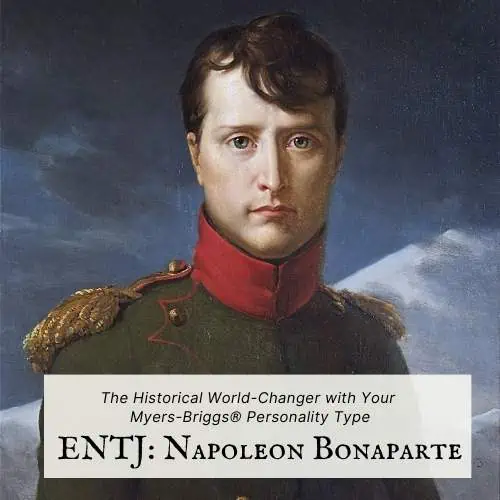
Moving on to the battlefield now, we meet an iconic figure who epitomizes ENTJ to the core – none other than Napoleon Bonaparte, the French military and political leader who gained worldwide fame for his tactical prowess and strategic insight. This guy didn’t just lead France to claim large parts of Europe, he practically redefined the art of warfare.
ENTJs are known for their big-picture vision, assertiveness, and lightning-fast decision-making abilities, and boy, did Napoleon have these in spades! He was a man who thrived on challenges, always pushing forward, always setting the bar higher. His Te (Extraverted Thinking) function made him a natural leader, a man of action who wasn’t afraid to make tough decisions and take calculated risks.
His Ni (Introverted Intuition) function can be seen in his ability to see the bigger picture, to strategize, and to anticipate his enemy’s moves. He had the uncanny knack of thinking several steps ahead, turning the tide of battles and winning wars that seemed unwinnable.
But it wasn’t all about warfare. Napoleon was also a great reformer, introducing progressive laws and regulations, such as the Napoleonic Code, which are still in place today. You might say his Fi (Introverted Feeling) came into play here, influencing his decisions and shaping his vision for a modern society. He was passionate about creating change and leaving a lasting impact on the world.
So if you ever find yourself in a leadership position, channel your inner Napoleon. Be confident, be decisive, and above all, think big! Who knows, with some ENTJ charisma and strategic thinking, you just might conquer the world (or at least your goals).
Want to know more about ENTJs? 24 Signs That You’re an ENTJ, the Director Personality Type
ENFJ – Martin Luther King Jr.

Now let’s take a moment to explore the civil rights legend, Martin Luther King Jr.. Remembered as a charismatic leader who used his voice as a beacon for change, King was the embodiment of the ENFJ’s idealistic, driven, yet deeply empathetic nature.
King’s Fe (Extraverted Feeling) is evident in his extraordinary empathy and his ability to connect with, understand, and mobilize people of diverse backgrounds towards a common goal. He knew just how to appeal to the collective conscience, demonstrating the defining ENFJ trait of being able to glean the emotions of others and adjust his speeches accordingly.
His Ni (Introverted Intuition) is reflected in his ability to inspire with a vision of a more just and humane future. King was not just a dreamer; he was a visionary who saw the potential for change and knew how to communicate that vision in a way that resonated with the hearts and minds of people.
Mirroring his Se (Extraverted Sensing), King was not a man to sit idly by. He was a man of action, leading marches and peacefully protesting for the rights and freedoms of African Americans. He was deeply in tune with the realities of his time, using his influence to effect tangible change.
If King was around today, he’d likely still be using his innate ENFJ traits to unite people and advocate for equality and justice. And in the spirit of King and all ENFJs out there, may we remember to use our own voices and actions to advocate for a world that respects and values all its inhabitants.
Find out more about ENFJs: ENFJ Characters We Can’t Help But Love
INTJ – Nikola Tesla
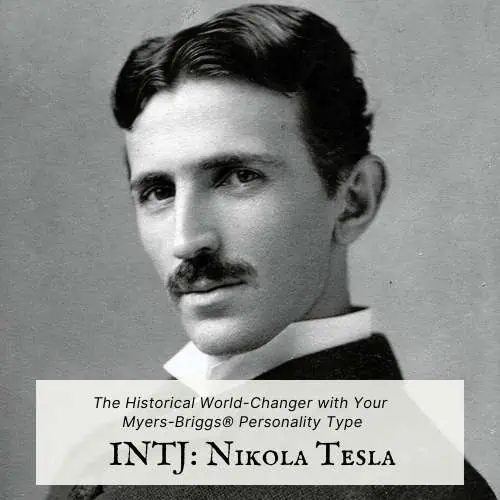
Let’s now dive into the world of scientific revelation, and who better to represent the INTJ personality than the man who practically invented the 21st century while living in the 19th – Nikola Tesla. Think about an INTJ – innovative, fiercely independent, with a mind that’s constantly buzzing with ideas. That’s Tesla in a nutshell.
Tesla’s Ni (Introverted Intuition) was off the charts. He was able to envision complex scientific concepts fully formed in his mind before putting them into practice. I mean, the man claimed he had visualized the entire alternating current motor system before even sketching it out. That’s like cooking the perfect soufflé in your mind, without breaking a single egg (times 1000).
Next up is his Te (Extraverted Thinking), seen in his systematic and methodical approach to his work. Tesla was a relentless experimenter, tweaking and tinkering until his inventions were just right. He didn’t just throw a bunch of science at the wall to see what would stick; he was methodical, precise – a real ‘measure twice, cut once’ kind of guy.
Tesla’s Fi (Introverted Feeling) is evident in his lifelong commitment to scientific discovery, driven by a deep desire to improve the world, not just to gain fame or fortune. His life was a testament to a kind of nobility you don’t find in your average inventor: he tore up a contract that would have made him one of the richest men in the world, just so his friend wouldn’t go bankrupt.
Finally, his Se (Extraverted Sensing), while not as strong, is evident in his ability to build intricate, functional devices from his theories. It’s one thing to have an idea, it’s another to make it a reality.
Tesla was a man ahead of his time, a true embodiment of the INTJ’s forward-thinking and independent spirit. If he were here today, he’d probably be solving the world’s energy crisis from his basement while we’re all still fumbling with our iPhone chargers. So, for all the INTJs out there, keep thinking big. Who knows, you just might light up the world.
Discover more about INTJs: 10 Things People Misunderstand About INTJs
INFJ – Mary Wollstonecraft
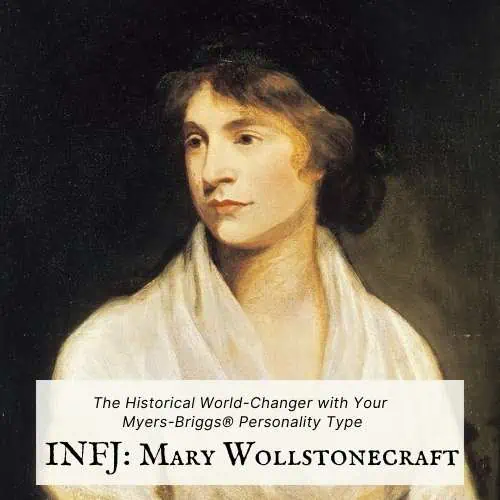
Let’s venture into the realm of socio-political reform and encounter an extraordinary example of an INFJ: Mary Wollstonecraft, the pioneer of women’s rights in the 18th century. Imagine an INFJ – insightful, purposeful, and somewhat reserved but with a burning passion for their beliefs. Well, meet the one-and-only Wollstonecraft.
Mary’s Ni (Introverted Intuition) was rather striking, and ahead of its time. She had this innate ability to look beyond the societal norms of her time and envisage a future where women would stand equal to men. She had this clear, compelling image of gender equality long before it was trendy, and let’s be honest, that was a gutsy move in the 1700s.
Then there’s her Fe (Extraverted Feeling), clearly manifested in her empathetic understanding of the plight of women. This empathy fueled her advocacy, giving voice to those whose voices were stifled. She didn’t just empathize; she gave speeches, wrote essays, and did whatever she could to get the message across in a way that would appeal to shared values of both men and women.
Her Ti (Introverted Thinking) is evident in her rigorous analytical approach to the societal structures of her era. She didn’t just accept the status quo; she dissected it, understood its flaws, and sought to rectify them. She was a thinker, a philosopher – someone who could take a step back and look at the bigger picture.
Lastly, her Se (Extraverted Sensing) was evident in her practical approach to activism. She wasn’t just an armchair philosopher; she was on the frontlines of the women’s rights movement, using her influence to push for tangible change.
Mary Wollstonecraft was a woman of immense courage and vision, embodying the INFJ’s passion for advocacy and societal reform. If she were around today, she’d no doubt be leading the charge on the front lines of another significant social movement. So, to all the INFJs out there, keep fighting the good fight. The world needs your visionary spirit.
Discover more about INFJs: The 10 Best Careers for INFJs
ESTJ – Henry Ford
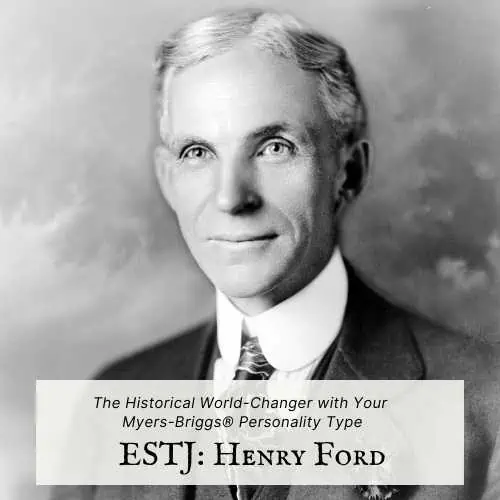
Now let’s pay homage to the man who probably invented your morning commute, Mr. Henry Ford. If you’re an ESTJ, this is your guy — organized, practical, and a bit stubborn. You know, the kind of person who’s more reliable than your smartphone’s alarm clock.
Ford was a poster child for Te (Extraverted Thinking). I mean, he actually broke down the entire process of building a car into tiny little tasks and then set up a production line. It’s like he was playing a giant game of Tetris, where all the blocks fit perfectly, and voila — a Model T pops out at the end.
His Si (Introverted Sensing) was always hard at work. Ford relied on past experiences to guide his actions, which is pretty evident with his “if it ain’t broke, don’t fix it” approach. And let’s not forget his famous quote “Any customer can have a car painted any color that he wants so long as it is black.” Now there’s a man who knows what he likes and sticks with it.
Ford’s Ne (Extraverted Intuition) can be seen in his innovative approach to car manufacturing. You know, the way he saw not just cars, but a whole new mode of transportation for everyone. It’s like he looked at a horse and buggy and thought, “Yeah, we can do better.”
Finally, there’s his Fi (Introverted Feeling), which is maybe a little harder to spot, but it’s there in his desire to make cars affordable for the average person. Ford didn’t just want to make a buck; he wanted to revolutionize the way people live.
So there you have it, the man who basically invented the 9 to 5, Mr. Henry Ford. If he were here today, he’d probably be trying to figure out how to make a flying car affordable for us all. So, to all the ESTJs out there — keep organizing, keep innovating. And maybe one day, you’ll revolutionize our commutes again. We could all do with a little less traffic, couldn’t we?
Find out more about ESTJs: A Look at the ESTJ Leader
ESFJ – General Colin L. Powell
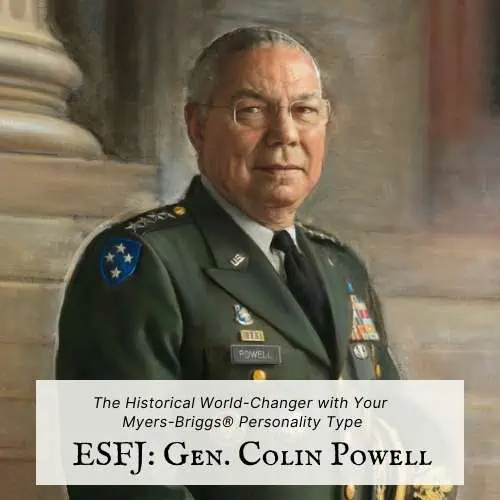
Moving on to a man who knew how to make a decision and stick with it — General Colin L. Powell, a quintessential ESFJ. Powell is best known for his tenure as the U.S. Secretary of State and Chairman of the Joint Chiefs of Staff, notable roles that he navigated with the decisiveness and personal responsibility characteristic of the ESFJ personality type.
Powell’s Fe (Extraverted Feeling) shone through his quote, “Leadership is all about human connections. It’s all about conveying to the followers that you believe in them … and that we are all in this together.” This epitomizes the ESFJ’s commitment to harmony, community, and the wellbeing of others.
In terms of Si (Introverted Sensing), Powell’s approach to decision-making was highly influenced by past events and experiences. He was known for his “Powell Doctrine” — a military strategy that advocated for overwhelming force to maximize success and minimize casualties, a lesson learned from past conflicts like Vietnam. His doctrine reflected his reliance on precedent and the lessons learned from history, a trademark characteristic of Si.
Powell’s quote, “I will take care of you, you will take care of me, we will sacrifice for one another. That’s what keeps a military unit bonded together,” speaks volumes about his Fe (Extraverted Feeling). This sentiment encapsulates the ESFJ’s prioritization of group cohesion, mutual support, and a strong sense of community. For Powell, the group’s wellbeing was paramount, and he saw his role as both a protector and a member of this group. This perspective is typical of ESFJs, who are often driven by a desire to maintain harmony and mutual support within their communities.
Explore more about ESFJs: 10 Things You Should Never Say to an ESFJ
ISTJ – George Washington
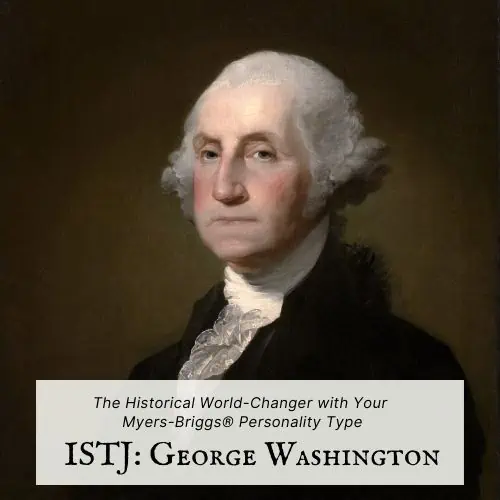
ISTJ – George Washington
Let’s turn back the clock and look at a figure from the annals of history, the man who could never tell a lie, George Washington. For all of you ISTJs out there, here’s an individual who exemplifies your virtues of dedication, integrity, and practicality.
Washington’s Si (Introverted Sensing) is evident in his practical, methodical approach to decision-making. He didn’t just shoot from the hip; he deliberated. He thought things through and then stuck to his principles, just like a true ISTJ. Take his crossing of the Delaware River, for example. He didn’t just wake up one morning and say, “Hey guys, let’s surprise attack the Hessians.” No sir, he planned it meticulously beforehand.
Washington’s Te (Extraverted Thinking) is also unmistakable in his leadership style. He was known for being a strict commander who expected discipline, order, and obedience from his troops. He embodied the saying “lead by example,” as he was always the first to arrive and last to leave camp, setting high standards for others to follow.
His Fi (Introverted Feeling) can be seen in his profound sense of duty, and his strong personal values. He didn’t want to be king; he wanted a nation built on principles of liberty and justice — talk about having a moral compass!
Finally, his Ne (Extraverted Intuition) was at play in his ability to adapt and respond to the changing circumstances of the Revolutionary War. He knew when to retreat, when to attack, and when to sit around in Valley Forge and freeze his wooden teeth off.
So, to all the ISTJs out there, keep doing what you’re doing. Keep being the dependable, hardworking individuals you are. After all, you’re in good company. George Washington would be proud.
Discover more about ISTJs: The ISTJ Leader
ISFJ – Mother Teresa

Let’s now turn our attention to the epitome of caregiving, the symbol of selfless service, and the embodiment of an ISFJ — Mother Teresa. For all ISFJs out there, you share your personality type with a Nobel Peace Prize laureate.
Mother Teresa’s Si (Introverted Sensing) is reflected profoundly in her quote, “Not all of us can do great things, but we can do small things with great love.” This encapsulates the ISFJ’s practical and hands-on approach to helping others. They are not necessarily looking for grand gestures or recognition; they want to make a difference in their own way, and often those ways are through meeting practical needs.
Her Fe (Extraverted Feeling) showed up in her relentless efforts to provide care and compassion to those who were overlooked and forgotten by society. She once said, “We think sometimes that poverty is only being hungry, naked, and homeless. The poverty of being unwanted, unloved, and uncared for is the greatest poverty.” It’s classic Fe to understand that people’s needs go beyond just the physical.
Coming to her Ti (Introverted Thinking), it was quietly at work behind the scenes, helping her strategize how to expand her charity work to more countries and reach more people in need. It’s safe to assume that one doesn’t open 517 missions in over 100 countries without having a good bit of analysis going on behind the scenes.
So, if you’re an ISFJ, you’re in good company. You share a personality type with a woman who moved mountains with her humility and changed the world with her love. And to all the ISFJs out there, remember, in the words of Mother Teresa, “Love begins at home, and it is not how much we do, but how much love we put in the action that we do.”
Learn more about ISFJs: 24 Signs That You’re an ISFJ, the Protector Personality Type
What Are Your Thoughts?
We hope you’ve enjoyed this journey through the world of MBTI personality types, seeing how they manifest in some of the world’s most notable figures. But enough about us, it’s your turn now. Are you an ESFJ like Powell, an ISTJ like Buffett, or an INFJ like Mary Wollstonecraft? Or do you identify with a different personality type altogether? Feel free to drop your type in the comments below, along with any thoughts, reflections, or stories about your own personal experiences.
Find out even more about your personality type in our eBooks, Discovering You: Unlocking the Power of Personality Type, The INFJ – Understanding the Mystic, The INTJ – Understanding the Strategist, and The INFP – Understanding the Dreamer. You can also connect with me via Facebook, Instagram, or Twitter!









It is interesting to share a personality type with a fellow biologist, although I don’t believe that his intentions were iconoclastic per se, but more a desire to present alternate ideas from a detached, purely observational perspective (albeit based upon limited information at the time) as INTPs are wont to do. In regard to your intro however I would point out that the reason most of these figures were able to go out into the world and make waves was that their needs were being provided by others – wives, mothers, housekeepers who cooked their meals and mended their clothes. Someone has to do these things, and we’re seeing the consequences of reliance on takeout and factory-made food (as well as fast fashion). Not the topic of this blog I realize, but not everyone can take life by the horns as it were and bend it to their wills. It’s neither fair nor unfair; it’s just the way it is. But even those not on the front lines can find that they impact the world in subtler but possibly more meaningful ways.
Shakespeare is a huge mystery. We don’t even know his identity to this day. There are various competing theories. His works may be done by several different people according to literary authorities. Not credible to type people we don’t know.
I’m either INFP or ENFP, and I’m perfectly happy to share a type with either of these me!
Martin Luther King and Mother Teresa were both INFJs. Look them up before writing this bullsh*t.
I agree with him being INFJ, but not sure about her. Maybe she was too practical to be INFJ.
I genuinely enjoyed your article, thank you.
As an INTP they’re always in the same field, no big surprise here x)
Would it be possible to do the same topic with women or is it too difficult to find enough women? Well we know they exist but they’re usually not very well-known, sadly, so I don’t know if it’s possible to achieve
It disturbs me that Nicola Tesla is held up as the personification of an INTJ, as Mr. Tesla was a mentally disturbed man, however, brilliant, who died, lonely, and in debt
As always, an interesting and fun article. I wanted to point out that Thich Nhat Hanh died in January of 2022. As an INTJ, I found his message of mindfulness through connection to the senses to be very aspirational, if not the easiest to do in practice.
What a fun and, at the same time, inspirational article!! I enjoyed reading this so much and I can truly relate to my Personality Type Icon (as well as to those of the people I know and follow as well). Thank you Susan, for the huge amount of research, effort and edtail that you put into these articles!